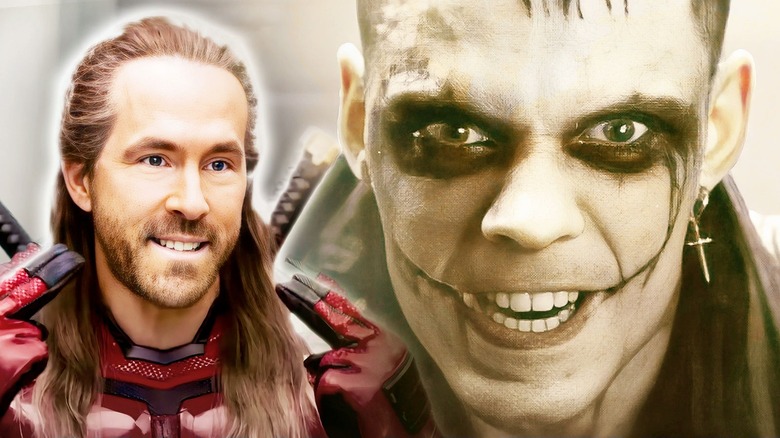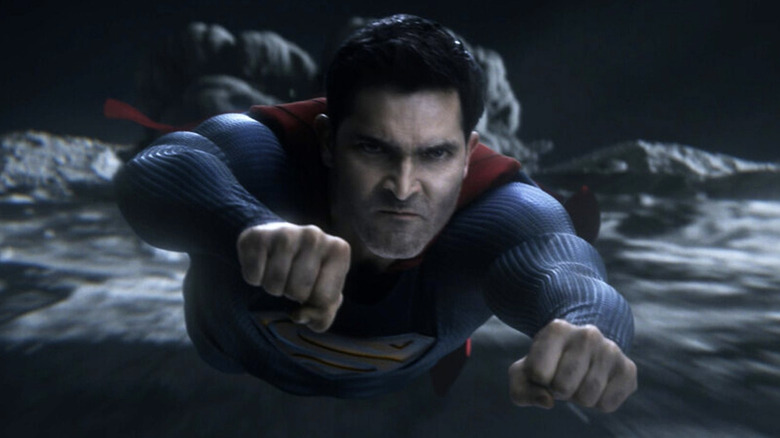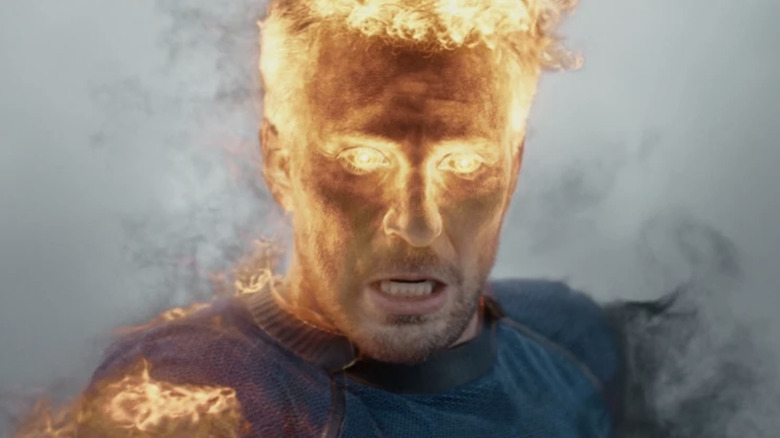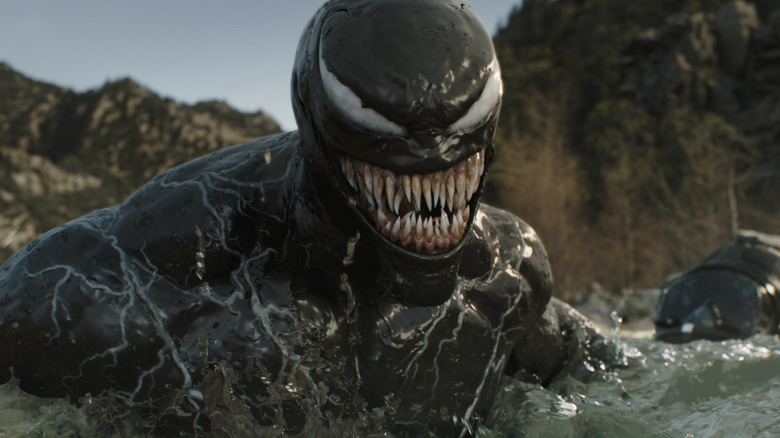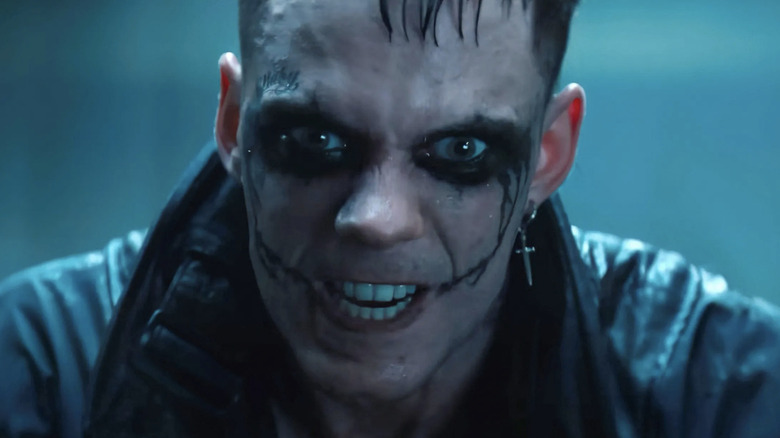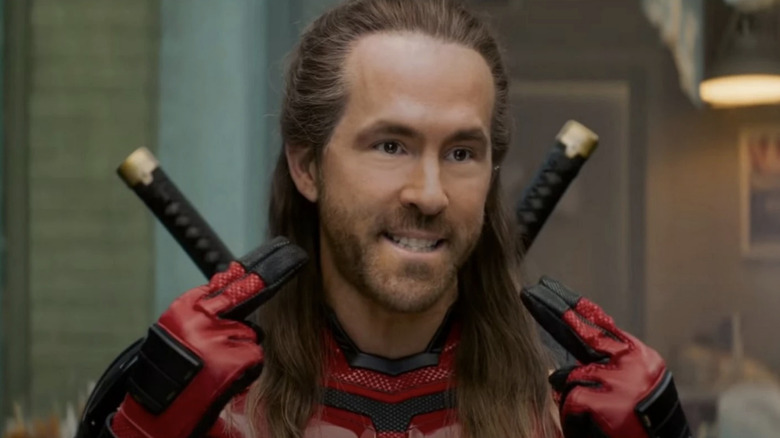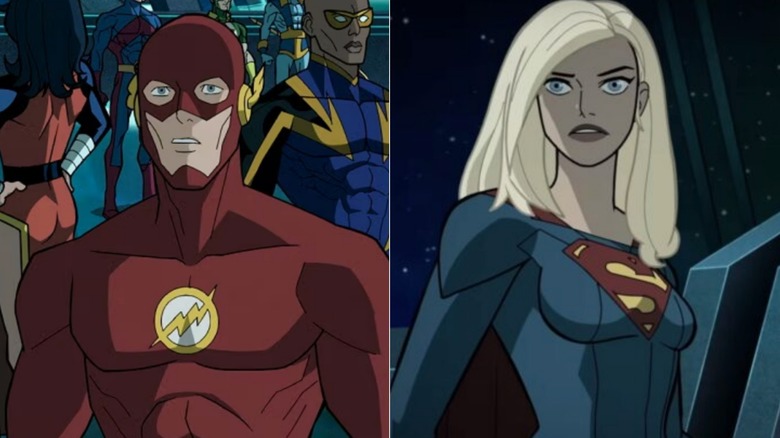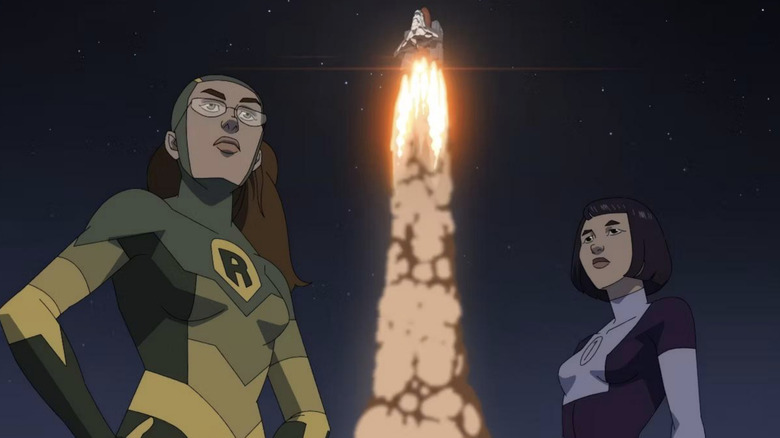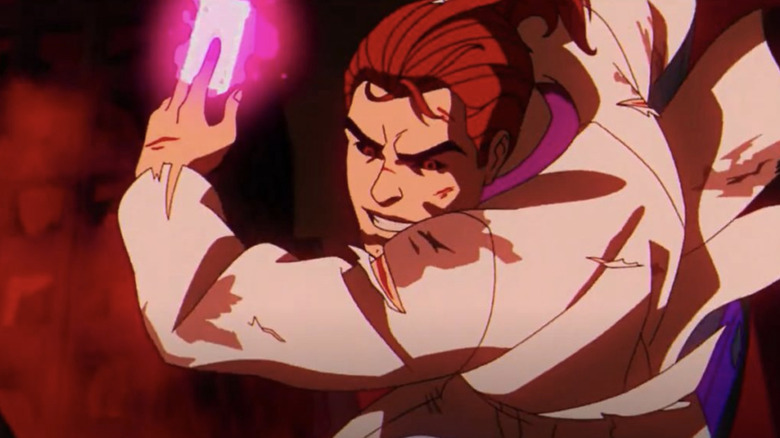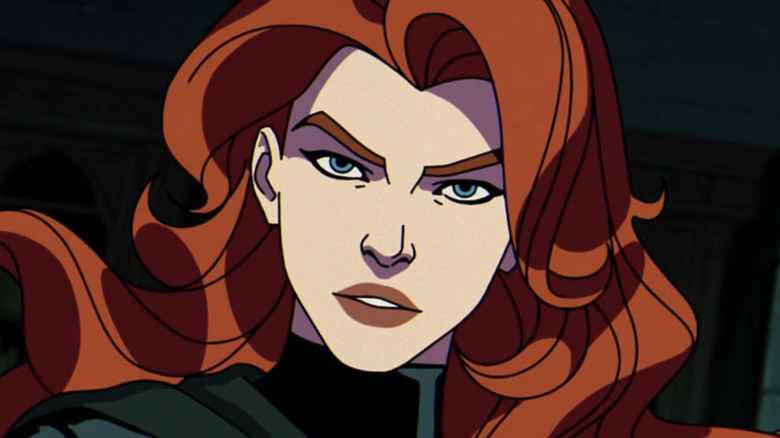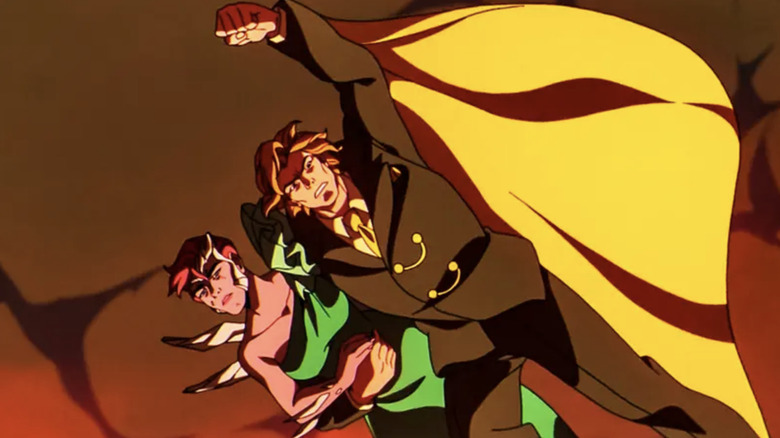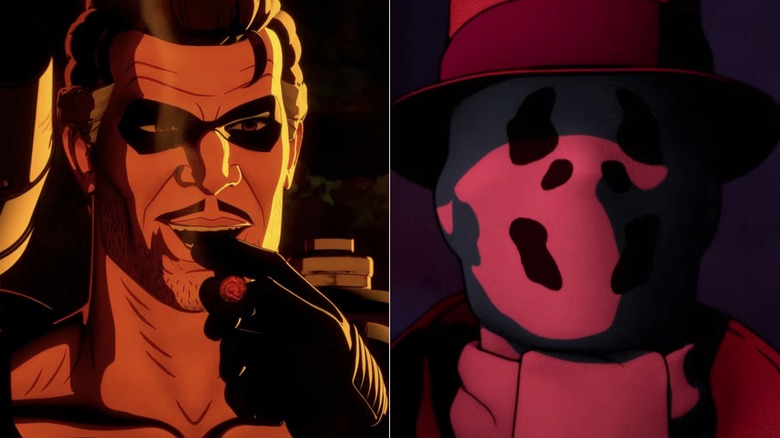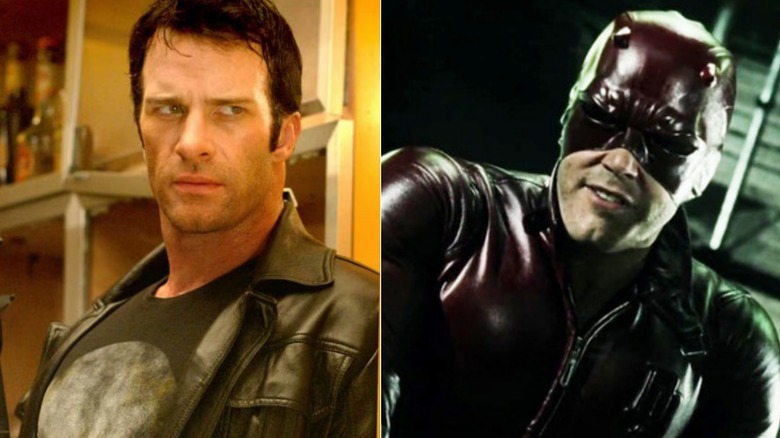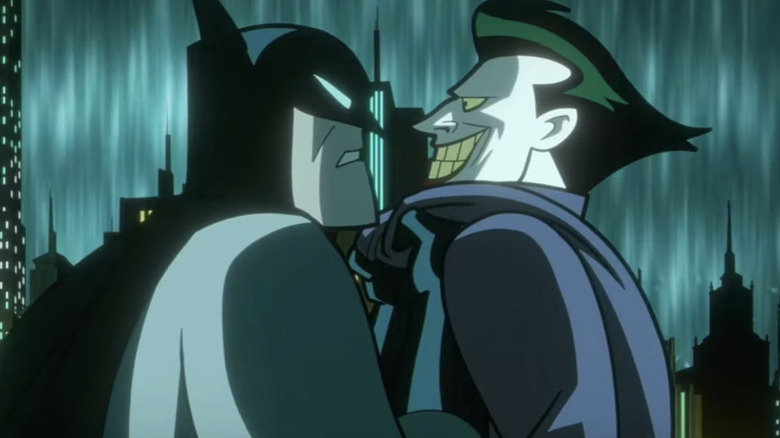Superheroes Who Died In 2024
Considering that we currently live in a day and age where superhero movies and television shows are a dime a dozen, it's not surprising that not every costumed hero makes it out alive. With the advent of the Marvel Cinematic Universe at the end of the early 2000s and the reign of DC Comics-inspired television in the 2010s, the 2020s are still anyone's game.
As the MCU continues, DC begins to restructure itself, and other superhero stories are told, there have been plenty of superhero characters who we've watched die on screen in this past year. Though there are likely dozens of others throughout all of superhero media, we're sticking strictly to film and television here. Some of these might be news to you, while others have perhaps been a long time coming. Either way, these are some of the most heartbreaking deaths in comic book-inspired stories to occur in 2024 alone.
Superman
"Superman & Lois" ended its powerful third season with the arrival of Michael Cudlitz's Lex Luthor, who creates his own version of the supervillain Doomsday in order to ensure that Superman (Tyler Hoechlin) stays dead and Lois Lane (Elizabeth Tulloch) is punished for getting him thrown in prison. Season 4, which doubles as the final season after the CW canceled "Superman & Lois," opened with a continuation of the brawl between the Man of Steel and his monstrous opponent, and it ended about the same way it always does. Yes, Superman actually did die on his own show, and in the first episode back to boot.
The fallout of Superman's death — his heart ripped out by Doomsday, only to be delivered to Lex Luthor — has been hard to watch. As Lois and her sons mourned their husband and father, we couldn't help but wonder if this was really it. Although Clark Kent was still appearing in flashbacks during the first few episodes of the season, it seemed as if the Man of Steel was truly gone after all. But after Lois' father, General Sam Lane (Dylan Walsh), heroically sacrificed himself by giving his heart to save Superman, Kal-El was restored to life in his Fortress of Solitude.
Of course, even though Superman is resurrected, he's not the same. Now that he has a human heart, he has real limitations that he's never experienced before. He's even begun to age normally. However this plays out for the rest of "Superman & Lois," we're glad that at least one of the deaths on this list was reversed.
Human Torch
Longtime Marvel fans were thrilled to hear that Chris Evans was returning to the MCU in the cameo-filled "Deadpool & Wolverine." But we were even more enthused when it was revealed that he was playing not Steve Rogers aka Captain America, but rather his "Fantastic Four" character Johnny Storm, the Human Torch. It certainly wasn't the way we expected Evans to ever return to the world of Marvel superheroes, but it was a welcome surprise for sure.
Unfortunately, it was cut short pretty quickly. Having been pruned by the Time Variance Authority (TVA) and sent to the Void, Johnny aligns himself with a bunch of other heroes against the villainous Cassandra Nova (Emma Corrin). But things don't end well for the Human Torch. After meeting up with Deadpool (Ryan Reynolds) and Wolverine (Hugh Jackman), Johnny's powers are soon extinguished by Pyro (Aaron Stanford) before the trio is then captured. After bad-mouthing Nova, Johnny is forced to face the fatal consequences when the villain instantaneously removes his skin from his body.
It's probably the absolute worst way a superhero could die, and it doesn't help that Deadpool's big mouth is the reason he's killed in the first place. Of course, with Marvel Studios' upcoming "The Fantastic Four: First Steps," there will be another Human Torch to take Johnny's place at some point down the line, this time played by Joseph Quinn. Hopefully he can learn to make better acquaintances, and won't run his mouth to the wrong people.
The Venom symbiote
With a title like "Venom: The Last Dance," it's not hard to imagine how the titular Lethal Protector might fall in battle in the third and seemingly final outing of the "Venom" series. After Eddie Brock and Venom (Tom Hardy) are forced on the run, the pair find themselves chased by not just the people of Earth, but those from the symbiote's homeworld as well.
Knull (Andy Serkis), the overlord of the symbiote's homeworld of Klyntar, wants the Codex that was created when Venom resurrected Eddie from death back in the first movie. Because of this, it will likely mean that the two of them will die as Knull's enforcers invade the planet. Thankfully, that only proves half true. The duo end up at Area 51, where the Xenophages (Knull's symbiote hunters) attack. Realizing that the only way to save Eddie and stop Knull is by destroying the Codex, Venom sacrifices himself and dies in a vat of acid as Eddie is helpless to stop it.
Though Eddie is eventually saved and cleared of all the charges that Venom wracked up, he struggles to move on without his former symbiote life partner. To make things even more interesting, the "Venom: The Last Dance" post-credits scene introduces a black cockroach (possessed by a sample of Venom that the Imperium had claimed) that crawls out from the wreckage. This leaves us with a sliver of hope that Venom — more specifically, a piece of Venom — may still be out there.
The Crow
Considering the results, nobody was exactly surprised that "The Crow" bombed at the box-office. The 2024 remake is the second live-action attempt at adapting the original James O'Barr graphic novel, but unlike the 1994 Brandon Lee picture, it's unlikely this one will garner a cult following. The truth is, adding the Crow to this list is sort of a cheat. Indeed, one of the prerequisites to becoming the Crow in the first place means that one has to actually die, and that's exactly what happens to Eric (Bill Skarsgård) early in the film. But that's not all. After becoming the Crow to avenge his death and the death of his lover Shelly (FKA Twigs), he targets her killer, the villainous Vincent Roeg (Danny Huston).
While Eric does defeat Roeg, sending the villain to the underworld and saving Shelly's soul from damnation, he does so at the cost of his own life on Earth. When Shelly is revived on the very night she died, she's told that Eric gave his life for hers. While the Crow himself is still out there in the afterlife, he's effectively dead, having sacrificed himself to save the woman he loves. It's heroic for sure, but it's just too bad that "The Crow" isn't nearly as good as the version that came out 30 years prior.
Nicepool
Okay, so there are an untold number of Deadpool variants who all get slaughtered in "Deadpool & Wolverine," but the real tragedy is that we lose Nicepool (a character strangely not credited to Ryan Reynolds) along with them. Yes, he's still Wade Wilson, but one from another world who doesn't have the same regenerative healing factor as many of his variants. Also unlike most Deadpools, he's not the absolute worst, and prefers kindness to quippy one-liners and sarcasm. He also doesn't wear a mask because, unlike Deadpool, he's not trying to hide how he looks.
It's not surprising then when Nicepool's head is blown clean off by the Deadpool Corps after Deadpool uses him as a human shield. The merc with a mouth is unaware that his kinder variant doesn't have the same mutant abilities, and so he doesn't stand a chance on the battlefield. We don't know too much about where Nicepool comes from, but we do know that he dies a hero. Or, at least, that's what Deadpool tells Wolverine before the clawed mutant puts him in his place.
The Flash and Supergirl
We've been getting plenty of "Crisis on Infinite Earths" adaptations in recent years. Whether revisiting the original story in the comics or adapting it to live action in the Arrowverse, DC can never seem to put its most notable multiversal apocalypse behind it. 2024 also saw the "Crisis" return to prominence with the animated "Justice League: Crisis on Infinite Earths" trilogy, which was released digitally and on a direct-to-video basis throughout the year. Just as in the original comic book, there were some pretty heartbreaking deaths that occur, particularly those of Barry Allen, aka the Flash (Matt Bomer), and Kara Zor-El, aka Supergirl (Meg Donnelly).
These two famously died first in the original 1985 comic book series, and remained dead for quite some time going forward. Though they each escaped their fate in the live action Arrowverse adaptation (with Green Arrow dying in their place), "Justice League: Crisis on Infinite Earths" returns to form by killing off the Flash in "Part One" and Supergirl in "Part Three." While plenty of other heroes and variants die (we'll get to some of those in a moment), these two are the biggest losses of the DC animated "Tomorrowverse." And now that the DC Animated Movie Universe has come to a close, thanks to James Gunn's DC Studios rebrand, these versions of the Flash and Supergirl are gone for good.
Dupli-Kate and Shrinking Rae
"Invincible" really faked us out with this one, because although both Dupli-Kate (Malese Jow) and Shrinking Rae (Grey DeLisle) are seemingly killed in Season 2, Episode 5, "This Must Come as a Shock," they are both later revealed to actually be alive. In going up against the Lizard League, Shrinking Rae is literally eaten alive and every duplicate of Dupli-Kate is mauled to death in combat. It's a scene meant to be shocking and provocative, and to remind us that the Lizard League is actually more of a threat than the Guardians of the Globe ever thought.
The thing is, both characters are later revealed to be alive. Somehow, Rae makes it out of Komodo Dragon (Jay Pharoah) alive, though is immediately hospitalized for her injuries. But it isn't until the season finale, "I Thought You Were Stronger," that we learn that Kate too is actually alive. It turns out the original Kate quit superheroics to live a normal life, allowing one of her duplicates to continue on as the main Dupli-Kate on the Guardians roster. Realizing that she can't turn her back on the Guardians, or her lover Immortal (Ross Marquand), forever, she reveals that she's still alive. Though Kate and Rae were quickly thought dead, "Invincible" played us all along.
Gambit
Don't worry, Channing Tatum's Gambit from "Deadpool & Wolverine" is still safe. Unfortunately, not every multiversal variant of the card-playing mutant is. Unlike what we saw on "Invincible," we know for sure that A. J. LoCascio's Gambit is dead and gone after the attack on Genosha in Episode 5 of "X-Men '97," "Remember It."
As he and Rogue (Lenore Zann) reunite to defeat the newly reborn Master Mold, Gambit ends up sacrificing himself to defeat the mutant-killer — and to save his true love. Given how early in "X-Men '97" this attack takes place, audiences were floored by Gambit's sudden demise, especially considering his hope for a real future with Rogue.
Of course, Gambit isn't the only mutant to die in the attack on Genosha, but his death is arguably the most heroic. Not only does he save countless lives by stopping the Master Mold, but he pushes his powers to their absolute limit in the process. If any X-Man deserves to be honored for their superheroics, it's the animated Gambit.
Madelyne Pryor
Speaking of heroes killed in the attack on Genosha, poor Madelyne Pryor (Jennifer Hale) never gets the ending she deserves. A secret clone of Jean Grey, Madelyne is inserted into the X-Men's lives at some point either during or after the end of "X-Men: The Animated Series," unbeknownst to anyone on the team. This includes Jean's husband, Scott Summers aka Cyclops (Ray Chase), who has a child with Jean's clone.
But when all is revealed, the X-Men turn on the clone (who dons the name Madelyne to avoid confusion), especially after Mr. Sinister (Christopher Britton) brainwashes her into becoming the villainous Goblin Queen. Madelyne is eventually able to move on from all of that, building a life for herself on Genosha and starting over as a heroic leader for her people.
Unfortunately, it all ends far too soon. Although her son, Cable (Chris Potter), travels from the future to warn her of her death, he's unable to prevent it. The time-traveling mutant watches helplessly as his mother is killed in the initial shockwave of the attack, her body later found and put to rest by the survivors. Considering how heroic Madelyne was when living as Jean, her potential as a character going forward was endless. While "X-Men '97" probably thought it would be confusing to have two Jean Greys on the show, this clone never got a fair shake.
Banshee and Marrow
Though we didn't see much of either Banshee (David Errigo Jr.) or Marrow on "X-Men '97," we do know that both heroes die in the attack on Genosha. At different times in the comics, both characters have been prominent members of the X-Men. In fact, in the show's own continuity (as featured previously in "X-Men: The Animated Series"), Banshee has worked alongside the mutant heroes on more than one occasion.
But "X-Men '97" won't be bringing them back again, as these two are tragically vaporized in "Remember It" when a Sentinel gets hold of them. Unable to get them to safety in time, Banshee is murdered mercilessly by the mutant-killing machines, and Marrow doesn't get much of a chance to escape or fight back either. It's a somber and fateful end for two characters who have much larger roles in the world of Marvel Comics.
The Comedian and Rorschach
The Comedian has technically been dead since the '80s, but since we're talking film and TV here, we'd be remiss if we didn't mention that the character dies yet again in the recent animated feature, "Watchmen Chapter I." This new adaptation of the original Alan Moore graphic novel is meant to be more accurate to the comic book than ever before, which unsurprisingly means opening the story with the death of Edward Blake, aka the Comedian (Rick D. Wasserman).
To call the Comedian a superhero may be a stretch, but considering his place on the Watchmen, we can't exactly ignore him. This problematic figure is taken out at the beginning of the tale, and the mystery of his murder fuels the plot. "Watchmen Chapter II" continues the story from Rorschach's (Titus Welliver) jailbreak to the very end of the classic DC graphic novel, and at this point, we all know how it ends. Rorschach dies as a result of sticking to the truth, and proves himself the only real hero in the story who cares about the concept.
Again, Rorschach's death doesn't come as a surprise, but considering the reason behind it, it still feels pretty tragic. If the original graphic novel and the greater DC Universe tells us anything, it's that, at the very least, his legacy will live on, and the truth about Ozymandias' (Troy Baker) actions will eventually come to light.
Many of the old Marvel heroes
Though Elektra (Jennifer Garner), Blade (Wesley Snipes), X-23 (Dafne Keen), and Gambit all survive their time in the Void in "Deadpool & Wolverine," not every Marvel hero from the pre-MCU era of superhero movies has made it through. Sure, we already heard about the tragedy of Chris Evans' Johnny Storm, but other characters' deaths are alluded to in the third "Deadpool" outing as well.
Specifically, we discover that Ben Affleck's Daredevil, as well as versions of the Punisher, Magneto, and Quicksilver, all perish at the hands of Cassandra Nova and her diabolical forces. It's a shame that we don't get to see Affleck suit up as Daredevil one final time, or even Thomas Jane reprise his role as the Punisher, but at least we know they were out there.
Considering that Marvel Studios likely has plans for Magneto and the X-Men, and "Daredevil: Born Again" is already set to reunite Charlie Cox's Daredevil with Jon Bernthal's Punisher, perhaps there were other reasons for these old Marvel legends not being included. Even Quicksilver (played by Evan Peters in the "X-Men" movies) has already appeared previously in "Avengers: Age of Ultron," played then by Aaron Taylor-Johnson. Either way, "Deadpool & Wolverine" dispatched some of the early 2000s' most notable Marvel characters off-screen, and that's a shame.
Basically every animated DC character
Of course, the MCU isn't the only franchise at fault here. DC does its own fair share of killing off long-beloved heroes. We mentioned that various other universes and continuities are destroyed in "Justice League: Crisis on Infinite Earths," and that's true. The worlds of the original "Super Friends" cartoons, the early 2000s' "Teen Titans" animated series, and the DC Animated Universe — which encompasses "Batman: The Animated Series," "Justice League Unlimited," "Batman Beyond," and more — are all wiped out during the Crisis event. Even the Tomorrowverse, the main continuity of the animated trilogy, is seemingly rebirthed at the very end, different than it was originally.
Does that mean that these characters can't come back? Certainly not, but they may never be the same again. This is especially the case considering that "Justice League: Crisis on Infinite Earths – Part Three" features the very final lines that Kevin Conroy performed as Batman before his death in 2022, and the same goes for Mark Hamill's Joker as he retired from the role following Conroy's passing. As a honorable tribute to the past animated worlds of DC, "Crisis on Infinite Earths" says a final farewell we just can't ignore.
